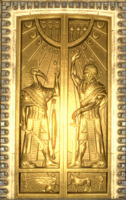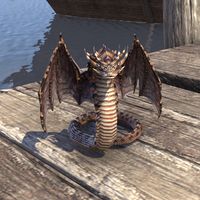Lore:Sep
Sep, also known as the Second Serpent, is the Yokudan and Redguard version of Lorkhan. He is said to have been created by Ruptga.[1] Sep lends his name to Sep adders and to Sep's Spine.
Mythology[edit]
According to the Yokudan creation myth, "Satakal the Worldskin": all things originated from Satak, the First Serpent on whose scales all worlds to come rested. Compelled by its Hungry Stomach, Akel, which stirred in response to the desire of the worlds to be saved as there was no space for things to exist, Satak started a neverending cycle of devouring itself and shedding its skin to be reborn and begin anew, becoming Satakal. With Satakals birth, things began realize their part in this cycle, and so began take names, becoming the first spirits. These spirits sought to escape Satakal's neverending hunger and found a way to slide between its Worldskins by moving at strange angles. This was called the Walkabout and through it was born a sanctuary from the cycle called the Far Shores. One of these spirits, Ruptga sired many children and was so tall he placed the stars in the sky to help other spirits escape as well. Ruptga, struggling to help so many spirits, gathered detritus of previous Satakal and from them created Sep, who would be his helper. Sep carried much of Satakal's Hungry Stomach within him, and so he at times would be driven mad, eating the Spirits he was meant to help. Eventually becoming bored of this cycle, Sep created the Skin-Ball from the dead remains of previous Worldskins, convincing some of the other spirits to join in, as they could escape the cycle by inhabiting a new world instead. This, however, was a trick. Too far from the Far Shores to jump back to, and too far from the real world of Satakal to survive, the deceived spirits began to die. Ruptga would not help the trapped spirits, grimly advising them to find new ways to reach the Far Shores. And if they could not, they must live on through their children, which was not the same as before. Though he refused to help the spirits deceived by Sep, Ruptga punished the Second Serpent for his trickery, squashing his head with a big stick until he died. From his corpse the Hunger fell out as all that was left of him. Sep, unable to return to Godhood like the rest of the world, continued on in two forms, either slinking about on Nirn as Deadskins, or swimming in the sky as a Hungry Void, that chases and tries to devour the stars.[2][1]
In some stories, Sep's hunger is said to reside deep within the core of every mortal, and to be related to the greed in men. These stories tell that the sinking of Yokuda was not caused by the Hiradirge, but rather by Sep's hunger growing strong in men and leading them away from proper reverence of the divines. It is said that some of the Yokudans decided to take what their growing greed demanded, and so were taken body and soul by the hunger of Sep. This growing avarice erupted into a great war during which forbidden rites were practiced and fell things which should never have been called forth were summoned. This conflict eventually caused Satakal to rise from the starry deeps and sink the continent of Yokuda, and it became a Time of Ending. The hunger of Sep is said to have been left behind in sunken Yokuda, for a time, as it can never be sated and, being part of every mortal, may rise again.[3]
It is said the modern Assassin Beetles of Hammerfell were originally known as Samara Scarabs. The Scarabs were companions to the Yokudans and favored among their children, and grew no larger than an ample millet loaf. After the sinking of Yokuda, the Scarabs were brought to Tamriel, a New Time and New Place. But in Tamriel the Scarabs continued to grow beyond their previous size and sprouted claws and mandibles, becoming Assassin Beetles, and so they had to be driven into the desert. This transformation is said to have occurred because the gods struck the Scarabs with the Hunger of Sep, an enduring warning to those who would become too avid.[3]
Some sources claim that, before deceiving the spirits, Sep stole one of the stars which Ruptga held in his hand and was using to form the Great Map and put it in his pocket. When Sep was killed, it is this star that fell out of his mouth in the form of a pearl. The pearl fell to the land and was covered by sand, and so came to belong to Zeht. It is said that this Pearl is the "Way and the Guide", the "light to the Far Shores and back again" and, when it is at last discovered again, water will flow over all the previous Worldskins and the time of Sep's Hunger will be over, the Hungry Stomach of Satakal at last sated. It is also said that the Hunger is what answers the call of the worlds to save them, and that the only real world is that of Satakal, as the stars can't be devoured.[4]
Worship[edit]
- Worshippers of Sep are known to recite the "Six Symbols of Sep".[5]
Gallery[edit]
Notes[edit]
- The myth of the spirits deceived by Sep being afflicted with death but being survived by the children they'd made bears some similarities to the Altmer creation myth. According to this myth, those spirits which stayed after Magnus and his followers departed to keep working on the new world so it wouldn't die, "had to make children just to last". Mortals are thus believed to be the relatively feeble descendants of the Aedra (or "ancestors") diminished from the might and stature of their progenitors over the generations. In Altmer myth Auri-El begs Anu to take them back after the deception, but Anu refuses. In Yokudan myth, the spirits ask Ruptga to take them back, but Ruptga refuses. A similar narrative of the creator spirits dying as a result of creation also exists in Aldmer belief as explained by the Psijic Order.[2][1][6] The Aedra themselves are said to be subject to death per the contract of creation, and are sometimes called the "dead gods", the "mortal gods" or "ghosts", and Mundus is said to be their "cemetery".[7][8][9][10][11] Given the parallels, these myths might be accounts of similar events from different cultural perspectives.
References[edit]
- ^ a b c Varieties of Faith... — Brother Mikhael Karkuxor of the Imperial College
- ^ a b The Monomyth
- ^ a b The Hunger of Sep — The Unveiled Azadiyeh, Songbird of Satakalaam
- ^ Hayyazin's dialogue in ESO
- ^ Yadugar's dialogue in ESO
- ^ Before the Ages of Man — Aicantar of Shimerene
- ^ Vastarie's dialogue in ESO
- ^ The Prophet's dialogue in Oblivion
- ^ Loremaster's Archive - Mehrunes Dagon & Daedra in the Second Era — Lyranth
- ^ Glorious Upheaval — Thendaramur Death-Blossom
- ^ Aedra and Daedra
|
|||||||||||||||||||||||


